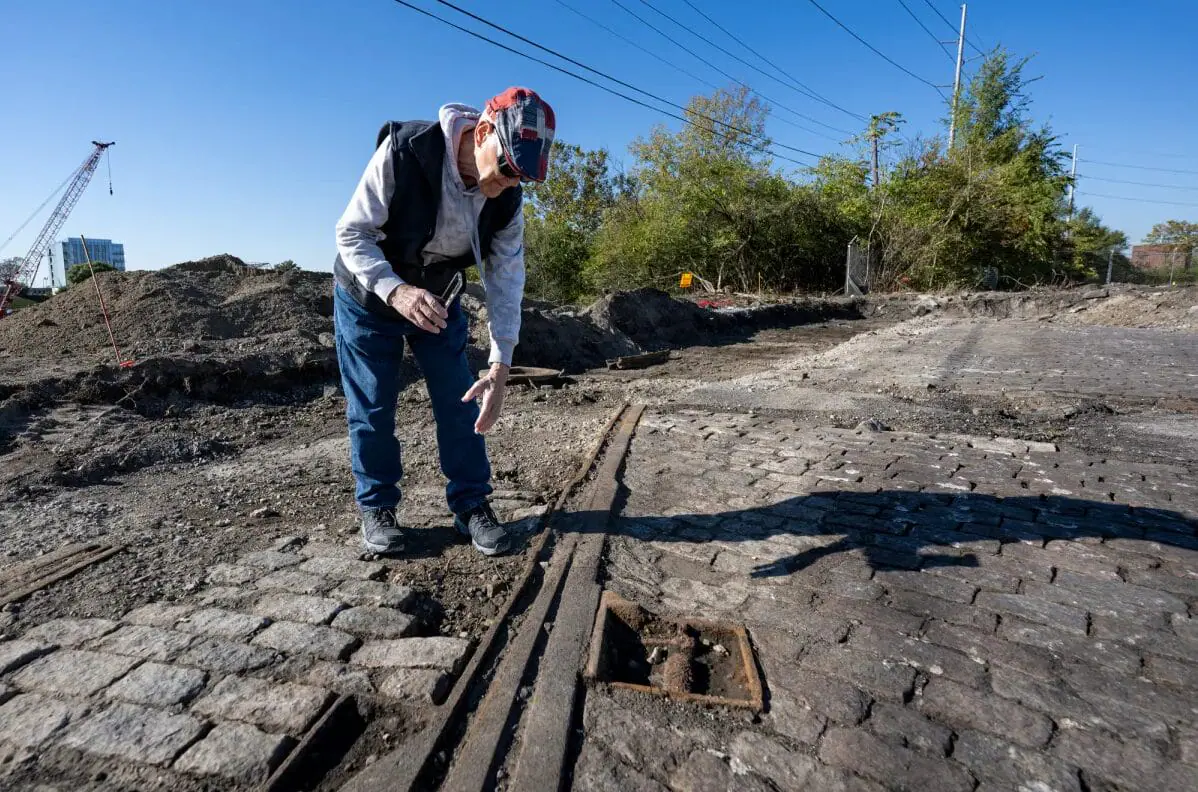City unearths piece of railway history near Greenlawn Cemetery
INDIANAPOLIS (MIRROR INDY) — City contractors have uncovered granite bricks and a few yards of railroad tracks that were once part of the city’s first electric freight terminal, supposedly the world’s largest.
The discovery happened during preparations for the Henry Street bridge project, which will cross the White River at the southeast part of downtown. The project is taking place near the historic Greenlawn Cemetery.
The Indianapolis Department of Public Works invited journalists to view the discovery before more sensitive excavation work that could uncover human remains begins later this fall.
In June, department officials announced that it would pursue a full excavation of the site before starting construction on the final part of the bridge project.
The news came after more than a year of conversations with community members who were concerned about the potential treatment of human remains at the site. The city’s project intersects with two of the four historic cemeteries — later collectively referred to as Greenlawn — where some of the earliest Indianapolis residents were buried.
“If the public is going to believe and trust in this, then you have to have that transparency,” said Leon Bates, a local historian and member of the community advisory group that has been providing feedback and research to the city.
What’s been found so far?
Workers have uncovered a few yards of granite brickwork and railroad tracks that were once part of the city’s electric freight terminal.
The terminal was “probably the largest” electric freight terminal in the world and was built to meet the demand of the growing freight business in Indianapolis, according to a 1924 article in Electric Railway Journal.
The station was short-lived. By the 1940s, the terminal had been paved over, and rail freight was replaced by trucking, according to Deedee Davis, who is conducting historical research on the site for the city.
City officials hope to reclaim the granite bricks and use them in an exhibit or potentially a memorial on the site.
What about human remains?
The city has not yet begun the deeper excavation that could uncover human remains, though that work is slated to begin within the next month.
In August, the city’s archaeological team sampled the area in a process called “coring,” which produced soil samples 1.5 inches in diameter and 25-30 feet deep.
Out of 10 cores taken, two contained human remains. All of the work was done under the supervision of archaeologists and in consultation with the community advisory group, according to the city.
City officials previously announced the discovery of a human hand bone found during utility excavation work in July 2023.
Workers for the adjacent site uncovered 87 burial shafts earlier this year, but that property is privately owned and unrelated to the city’s site.
What is the Henry Street bridge project?
The bridge will connect the future Elanco headquarters on the west side of the river to the area southeast of downtown. The second phase of construction, the part of the bridge that extends over the water, began last month.
When it’s finished, the bridge will be split 60/40 between pedestrian and vehicular traffic and will feature an extension of the Cultural Trail.
The bridge will bring a higher level of connectivity between Indianapolis’ downtown and the near west side, DPW Director Brandon Herget said.
“We think of Fountain Square as a cultural destination, as an important, vital, vibrant neighborhood in our community, and here we are standing today in a place that, geographic proximity wise, is closer to our downtown core,” he said. “I think that’s an important transition for a neighborhood that’s been longing for that type of investment.”
You can learn more about the bridge and the history of the site on the project’s website. You can also use that website to submit research about your family connection to Greenlawn.
What about the Eleven Park site?
Most of the former Greenlawn land is owned by Keystone Group, the development company owned by Indy Eleven team owner Ersal Ozdemir.
The future of the larger site has remained uncertain since Mayor Joe Hogsett’s administration and the City-County Council abandoned plans to pursue a professional soccer stadium there.
Alexandra Miller, spokesperson for Keystone Group, did not immediately respond to a list of questions from Mirror Indy on Oct. 17.
When reporters visited the city’s site the same day, the area owned by Keystone looked largely unchanged from how it appeared earlier this year.
Reach Mirror Indy reporter Emily Hopkins at 317-790-5268 or emily.hopkins@mirrorindy.org. Follow them on most social media @indyemapolis.
